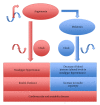The Angiotensin-melatonin axis
- PMID: 23365722
- PMCID: PMC3556444
- DOI: 10.1155/2013/521783
The Angiotensin-melatonin axis
Abstract
Accumulating evidence indicates that various biological and neuroendocrine circadian rhythms may be disrupted in cardiovascular and metabolic disorders. These circadian alterations may contribute to the progression of disease. Our studies direct to an important role of angiotensin II and melatonin in the modulation of circadian rhythms. The brain renin-angiotensin system (RAS) may modulate melatonin synthesis, a hormone with well-established roles in regulating circadian rhythms. Angiotensin production in the central nervous system may not only influence hypertension but also appears to affect the circadian rhythm of blood pressure. Drugs acting on RAS have been proven effective in the treatment of cardiovascular and metabolic disorders including hypertension and diabetes mellitus (DM). On the other hand, since melatonin is capable of ameliorating metabolic abnormalities in DM and insulin resistance, the beneficial effects of RAS blockade could be improved through combined RAS blocker and melatonin therapy. Contemporary research is evidencing the existence of specific clock genes forming central and peripheral clocks governing circadian rhythms. Further research on the interaction between these two neurohormones and the clock genes governing circadian clocks may progress our understanding on the pathophysiology of disease with possible impact on chronotherapeutic strategies.
Figures


Similar articles
-
[Research progress in control strategies of biological clock disorder].Sheng Li Xue Bao. 2023 Apr 25;75(2):279-290. Sheng Li Xue Bao. 2023. PMID: 37089102 Chinese.
-
Melatonin and stable circadian rhythms optimize maternal, placental and fetal physiology.Hum Reprod Update. 2014 Mar-Apr;20(2):293-307. doi: 10.1093/humupd/dmt054. Epub 2013 Oct 16. Hum Reprod Update. 2014. PMID: 24132226 Review.
-
The interactions between melatonin and the renin-angiotensin system (RAS) in vascular attenuation in diabetic and non-diabetic conditions.Acta Diabetol. 2025 Jun;62(6):801-809. doi: 10.1007/s00592-025-02479-2. Epub 2025 Mar 13. Acta Diabetol. 2025. PMID: 40080199 Review.
-
Role of circadian rhythms and melatonin in bladder function in heath and diseases.Auton Neurosci. 2023 May;246:103083. doi: 10.1016/j.autneu.2023.103083. Epub 2023 Mar 2. Auton Neurosci. 2023. PMID: 36871511 Review.
-
Circadian rhythms, insulin action, and glucose homeostasis.Curr Opin Clin Nutr Metab Care. 2014 Jul;17(4):343-8. doi: 10.1097/MCO.0000000000000061. Curr Opin Clin Nutr Metab Care. 2014. PMID: 24810916 Review.
Cited by
-
Cardioprotective Melatonin: Translating from Proof-of-Concept Studies to Therapeutic Use.Int J Mol Sci. 2019 Sep 5;20(18):4342. doi: 10.3390/ijms20184342. Int J Mol Sci. 2019. PMID: 31491852 Free PMC article. Review.
-
Melatonin as a Potential Adjuvant Treatment for COVID-19 beyond Sleep Disorders.Int J Mol Sci. 2021 Aug 11;22(16):8623. doi: 10.3390/ijms22168623. Int J Mol Sci. 2021. PMID: 34445329 Free PMC article. Review.
-
Efficacy of a Neuroimmune Therapy Including Pineal Methoxyindoles, Angiotensin 1-7, and Endocannabinoids in Cancer, Autoimmune, and Neurodegenerative Diseases.Clin Interv Aging. 2025 Apr 29;20:513-522. doi: 10.2147/CIA.S513910. eCollection 2025. Clin Interv Aging. 2025. PMID: 40330271 Free PMC article.
-
Effects of chronotherapy of benazepril on the diurnal profile of RAAS and clock genes in the kidney of 5/6 nephrectomy rats.J Huazhong Univ Sci Technolog Med Sci. 2013 Jun;33(3):368-374. doi: 10.1007/s11596-013-1126-7. Epub 2013 Jun 17. J Huazhong Univ Sci Technolog Med Sci. 2013. PMID: 23771662
-
Role of melatonin in respiratory diseases (Review).Exp Ther Med. 2022 Apr;23(4):271. doi: 10.3892/etm.2022.11197. Epub 2022 Feb 9. Exp Ther Med. 2022. PMID: 35251337 Free PMC article. Review.
References
-
- Bader M, Peters J, Baltatu O, Müller DN, Luft FC, Ganten D. Tissue renin-angiotensin systems: new insights from experimental animal models in hypertension research. Journal of Molecular Medicine. 2001;79(2):76–102. - PubMed
-
- Baltatu OC, Campos LA, Bader M. Local renin-angiotensin system and the brain: a continuous quest for knowledge. Peptides. 2011;32(5):1083–1086. - PubMed
-
- von Lueder TG, Krum H. RAAS inhibitors and cardiovascular protection in large scale trials. Cardiovascular Drugs and Therapy, 2012. In press. - PubMed
-
- Pevet P, Challet E. Melatonin: both master clock output and internal time-giver in the circadian clocks network. Journal of Physiology Paris. 2011;105(4-6):170–182. - PubMed
LinkOut - more resources
Full Text Sources
Other Literature Sources

